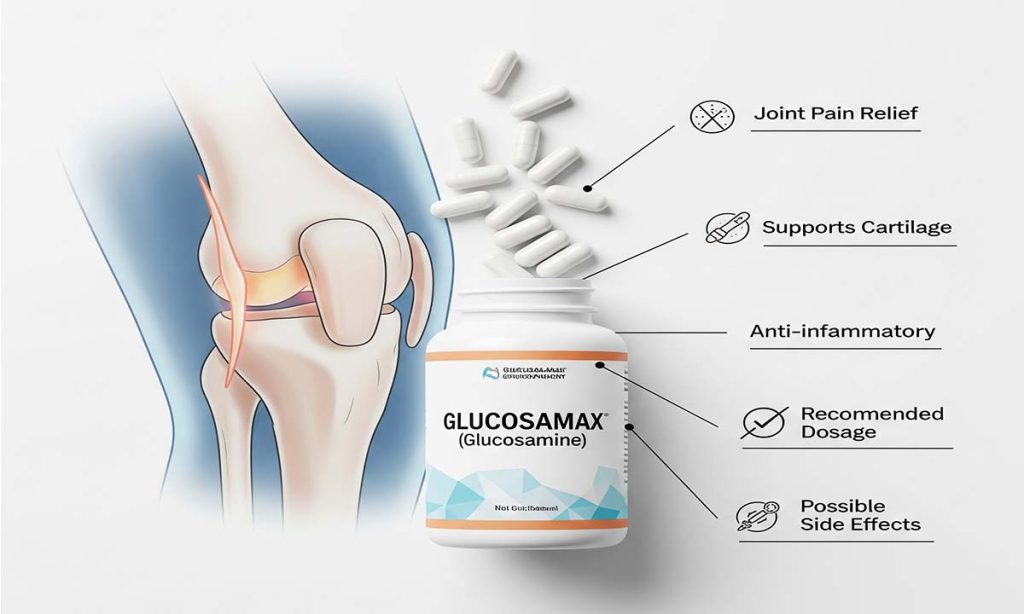Many people with aching joints turn to supplements like Glucosamax (a glucosamine product) in hopes of reducing pain and improving mobility. In this article we dive deep into what glucosamine is, how (and if) it works for joint health, its potential benefits, recommended dosage, and possible side effects. We’ll also touch on related products like Joint Flex Glucosamax 1500 mg and Joint Flex Glucosamax Plus. By the end, you’ll have a comprehensive understanding of glucosamine and whether supplements like Glucosamax deserve a place in your arthritis care routine on Glucosamax
Glucosamine is a natural compound vital for joint cartilage. It is often taken in supplement form (from sources like shellfish shells or made synthetically). For example, many joint support supplements provide glucosamine sulfate 1500 mg per day, sometimes alongside other ingredients. Products such as Joint Flex Glucosamax (glucosamine sulfate 1500mg) or Joint Flex Glucosamax Plus are examples of formulas used to support healthy joints. These supplements typically combine glucosamine with chondroitin, MSM, turmeric, or other nutrients. The goal is to nourish cartilage and maintain synovial fluid, potentially easing joint stiffness. But the big question remains: does it really work? We’ll examine the evidence below.

Glucosamine is available as oral pills and even topical creams. For example, some people apply joint lotions containing glucosamine to their knees or elbows for pain relief. Research emphasizes oral use, but topical forms exist. As we’ll see, most clinical studies focus on taking 1,500 mg/day of glucosamine (often sulfate) and measure outcomes like pain scores or cartilage changes.
Table of Contents
What Is Glucosamine (Glucosamax)?
Glucosamine is a naturally occurring amino sugar found in human cartilage – the tough, flexible tissue that cushions joints. Chemically, it contributes to the formation of glycosaminoglycans, key building blocks of cartilage and synovial fluid. (The image below shows glucosamine’s chemical structure.) Because of this role, glucosamine is theorized to support joint repair and lubrication Glucosamax
Chemical structure of glucosamine (alpha-D-glucosamine). Glucosamine is a small amino sugar crucial for cartilage and joint health.
Supplemental glucosamine is often harvested from shellfish shells (shrimp, crab) or produced synthetically. There are several forms: glucosamine sulfate, glucosamine hydrochloride (HCl), and N-acetyl glucosamine (NAG). These are not exactly interchangeable. Most scientific studies focus on glucosamine sulfate, which is the form with the strongest evidence for osteoarthritis. Glucosamine HCl is also common, especially in combination products, while NAG has much less research support Glucosamax
In North America, glucosamine is sold over-the-counter as a dietary supplement. In some countries (like much of Europe), prescription glucosamine sulfate is used for osteoarthritis. Notably, one Cochrane review pointed out that North American supplements are not tightly regulated, so the actual glucosamine dose can vary by brand. In any case, typical over-the-counter doses are 1,500 mg of glucosamine per day, often split into three 500 mg doses.
Glucosamine and Joint Cartilage
Osteoarthritis is the most common joint disease, characterized by the breakdown of cartilage that cushions bone ends. When cartilage erodes, bones rub together, causing pain and stiffness. In fact, over 32 million Americans have osteoarthritis, making joint health a major concern. Glucosamine’s appeal lies in its role as a cartilage component: by supplying the raw material for cartilage and synovial fluid, it may help maintain or rebuild joint tissue.
Illustration of a normal knee joint (left) vs osteoarthritic knee (right). In osteoarthritis, the cartilage cushioning the joint wears down, leading to pain and inflammation. Supplements like glucosamine (as in Glucosamax) are claimed to help protect this cartilage.
In healthy joints, articular cartilage (smooth white tissue) and the lubricating synovial fluid allow bones to glide with minimal friction. Glucosamine helps form collagen and other compounds essential to cartilage structure. Some laboratory studies suggest that glucosamine can inhibit enzymes that degrade cartilage and may promote cartilage synthesis. For instance, a small clinical study in young athletes (who had higher cartilage turnover from sports) found that taking 1.5–3 grams of glucosamine daily for 3 months significantly reduced markers of cartilage breakdown. This hints that glucosamine might have a joint-protective effect under certain conditions. However, that study was limited and more research is needed.
Overall, glucosamine’s natural function and preliminary studies provide a rationale for its use in joint health. However, we must ask: does this translate to noticeable benefits like pain relief or improved mobility in everyday people with arthritis?
Does Glucosamine (Glucosamax) Work? The Evidence
Studies on glucosamine have been mixed and sometimes contradictory. Many osteoarthritis trials have tested glucosamine (often with chondroitin) against placebo. The results vary depending on study design, glucosamine form, brand, and outcomes measured. Key points from the research:
- Clinical trial outcomes: A systematic Cochrane review (2005) found that high-quality trials of glucosamine showed pain improvement about the same as placebo, whereas lower-quality or older trials tended to favor glucosamine. In plain terms, the best-designed studies often fail to show strong benefit, but some earlier or lower-quality studies reported modest benefits. Interestingly, the Cochrane summary noted that users of certain glucosamine formulations (like the Rotta brand) did report more pain reduction in some trials, suggesting that specific formulations might matter. Overall, Cochrane concluded that “people with osteoarthritis who take glucosamine may reduce their pain and may improve their function, and will probably not have side effects”. However, the confidence in pain reduction was low, and averaged results were often not statistically significant.
- Meta-analyses: Several pooled analyses have reached similar conclusions: modest or no effect. For example, a 2023 Healthline review noted that research “inconclusively supports” glucosamine for long-term osteoarthritis management. Another review of 29 knee osteoarthritis trials (over 6,000 patients) found that glucosamine alone significantly reduced pain compared to placebo, but the combination of glucosamine+chondroitin did not add extra benefit. In short, evidence is inconsistent.
- Guideline statements: Reflecting the mixed evidence, expert guidelines differ. The American College of Rheumatology (2019) strongly recommends against using glucosamine (with or without chondroitin) for knee osteoarthritis, stating that “best data do not show any important benefits”. Likewise, the Osteoarthritis Research Society International (OARSI) 2019 guidelines advise against it. In contrast, the 2021 American Academy of Orthopaedic Surgeons lists glucosamine among supplements that may help mild-to-moderate knee OA, albeit with caution that evidence is inconsistent. The European ESCEO group strongly recommends crystalline glucosamine sulfate specifically for knee OA but discourages other forms. This split underscores that experts don’t all agree.
- Regulatory positions: In Europe, some glucosamine sulfate formulas are even prescription medications (e.g., “Donasel” in Italy). Many European rheumatologists endorse glucosamine sulfate. In North America, it remains an over-the-counter supplement. The variability in results is partly because supplements vary in quality and form.
In summary, glucosamine (Glucosamax) is neither a panacea nor a useless pill. Many patients report feeling some improvement (even if via placebo), and the risk is low. The Mayo Clinic notes that glucosamine sulfate “might provide some pain relief for people with osteoarthritis of the knee” and could help slow knee joint degeneration, though results are mixed. The bottom line from reviews is that glucosamine may offer mild benefit for some individuals, but robust proof is lacking. Because it’s relatively safe, some experts say it’s worth a try if you’re bothered by arthritis pain and cannot tolerate other medications.
Potential Benefits and Uses
Despite mixed evidence, glucosamine has several proposed benefits and uses, mainly relating to joint health:
- Osteoarthritis Pain Relief: The most-studied use is for osteoarthritis, especially of the knee. Several trials and user reports suggest that some people experience reduced joint pain and stiffness after taking glucosamine. For example, one analysis found that average pain scores improved more in glucosamine users than placebo (small effect). The Mayo Clinic notes that glucosamine sulfate “might provide some pain relief for people with osteoarthritis” and may slow cartilage breakdown. It’s reasonable for users with knee or hip OA to try glucosamine as part of a multi-pronged management plan (exercise, weight control, etc.).
- Improved Joint Function: Along with pain reduction, some studies report modest improvement in joint function. The same Cochrane summary mentioned “may improve physical function”. These could translate to being able to walk more easily or climb stairs with less discomfort. Again, effects tend to be small and vary by study.
- Cartilage and Joint Protection: By its nature, glucosamine helps form cartilage matrix. Some laboratory and animal studies show it may help maintain cartilage thickness or joint space. In the healthline review, regular glucosamine plus chondroitin usage was associated with a slower rate of cartilage degradation in athletes. Another large epidemiological study found that people who regularly took glucosamine supplements (over years) had lower rates of developing type 2 diabetes and cardiovascular events. Researchers speculate this may be due to glucosamine’s anti-inflammatory effects in the body. In one small trial, overweight adults taking glucosamine+chondroitin for a month saw a 23% drop in C-reactive protein (CRP), a marker of systemic inflammation, compared to placebo. Such results hint that glucosamine has broader anti-inflammatory properties, though whether this translates to clinical benefits beyond joints is unclear.
- Joint Mobility and Comfort: Anecdotally, many users say glucosamine makes their joints feel more flexible. Some supplements combine glucosamine with MSM (methylsulfonylmethane), turmeric, or collagen to enhance joint comfort. While high-quality data on MSM/turmeric combos is limited, glucosamine often appears in “joint flex” multi-ingredient products. The idea is that glucosamine provides the building blocks, while other ingredients add anti-inflammatory or lubrication effects.
- Other Conditions (limited evidence): Glucosamine has been marketed for a variety of other inflammatory and degenerative conditions (rheumatoid arthritis, tendonitis, etc.), but solid evidence is lacking. For example, early research suggests glucosamine HCl might slightly reduce pain in rheumatoid arthritis, but it doesn’t reduce swelling. It’s also been trialed in interstitial cystitis, IBD, and even multiple sclerosis, but no consistent benefits were found. Bottom line: the only well-supported use is for osteoarthritis/joint health.
In summary, if glucosamine works for you, it’s likely through mild pain relief, better joint lubrication, and reduced inflammation. These effects are subtle and typically take time to appear. Many experts advise giving glucosamine at least 2–3 months before judging effectiveness. It’s also key to combine it with proven strategies: exercise, weight loss, and PT. Supplements like Glucosamax are adjuncts, not replacements, to standard OA care.
Recommended Dosage and Forms
If you decide to try Glucosamax (glucosamine) supplements, here are some guidelines:
- Standard Dose: The typical dose studied for osteoarthritis is 1,500 mg of glucosamine sulfate per day, usually taken in divided doses (e.g. 500 mg three times daily). Some experts allow up to 3,000 mg (3 g) per day, but 1,500 mg is a common starting point. In practice, many joint health supplements (including “Joint Flex Glucosamax 1500mg” products) provide this amount in a single daily dose or split across pills.
- Form of Glucosamine: Glucosamine sulfate is the preferred form because it has been most widely studied and is often available in prescription-grade formulas. Glucosamine hydrochloride is another form often found in supplements; it may be less consistently absorbed. If you choose a combination product (e.g. with chondroitin or MSM), check that it provides a clear 1500 mg glucosamine (or slightly higher) in sulfate form. Note that N-acetyl glucosamine (NAG) has much less evidence and is not usually recommended by itself.
- With or Without Chondroitin/MSM: Many products marketed as “Joint Flex” formulas pair glucosamine with chondroitin sulfate (and sometimes MSM or boswellia). Chondroitin is also a cartilage component. The evidence for adding chondroitin is mixed – some studies show a benefit, others do not. However, taking them together is generally considered safe, and they may have complementary effects. If you do combine them, typical doses are 1,200 mg chondroitin plus 1,500 mg glucosamine daily (as in many trial protocols).
- How to Take: It’s best to take glucosamine with meals to minimize stomach upset. For example, split 1500 mg into breakfast, lunch, and dinner. Consistency is key: most supplements advise daily use for at least 8–12 weeks to assess effect. Do not expect overnight improvement; joint supplements often require several weeks to months to show results for those who will benefit.
- Quality & Brand: Since glucosamine is a supplement, product quality varies. Look for third-party tested brands (USP, NSF, ConsumerLab seals) to ensure potency and purity. Some glucosamine sulfate products use patented forms (like Rotta’s crystalline sulfate) that have been used in research. If the label says “glucosamine sulfate potassium chloride” or similar, know that often each capsule provides about 500 mg glucosamine (you may need 3 per day to reach 1500 mg glucosamine).
- Combining with Other Medications: Always tell your doctor you plan to take glucosamine, especially if you’re on blood thinners like warfarin, as glucosamine can enhance those effects (see next section). It may also interact with acetaminophen (Tylenol). Generally, avoid stacking multiple joint supplements beyond what’s recommended without medical advice.
Below is a quick dosage checklist:
- Take 1500 mg glucosamine sulfate daily (500 mg × 3) or as directed by a professional.
- Consider joint combination formulas (e.g. glucosamine+chondroitin) if recommended.
- Swallow with meals to avoid nausea.
- Continue use for at least 2–3 months before evaluating benefit.
- Choose quality brands; look for NSF/USP certification.
Always follow package instructions and consult a healthcare provider for personalized advice.
Safety and Side Effects
Glucosamine (Glucosamax) is generally well-tolerated, but you should be aware of possible side effects and precautions:
- Gastrointestinal Upset: The most common side effects are digestive: nausea, heartburn, bloating, diarrhea or constipation. These are usually mild. Taking glucosamine with food often reduces GI discomfort.
- Other Mild Effects: Some people report drowsiness, headache or skin rash. In clinical reviews, glucosamine is described as “generally safe”. There’s no evidence of serious toxicity, even at high doses, though it’s best not to exceed recommended amounts without guidance.
- Allergic Reactions: Because many glucosamine supplements are made from shellfish shells, anyone with a shellfish allergy should avoid them or use a vegetarian glucosamine (if available). Even if you can handle shellfish, be cautious: an allergy to shellfish proteins doesn’t always predict reaction to shell-derived supplements, but caution is warranted.
- Asthma and Glaucoma: A few studies raised concerns that glucosamine might worsen asthma in susceptible people or raise intraocular pressure in glaucoma patients. If you have asthma, monitor your breathing. If you have glaucoma or are at risk, discuss with your doctor before starting glucosamine.
- Blood Sugar: Earlier theories worried glucosamine could affect blood sugar because it’s related to glucose metabolism. However, human studies have not shown significant changes in blood glucose or insulin in people taking glucosamine. (Interestingly, a large observational study suggested glucosamine users actually had lower diabetes risk, though this does not prove causation.)
- Drug Interactions: Glucosamine can interact with certain medications. The most important interaction is with warfarin (a blood thinner): glucosamine (especially with chondroitin) can increase warfarin’s effect, raising the risk of bleeding. If you take warfarin (Coumadin) or similar, do not start glucosamine without close INR monitoring. Also, glucosamine may slightly reduce the effect of acetaminophen. No major interactions have been reported with NSAIDs like ibuprofen, but always double-check with your doctor or pharmacist.
- Pregnancy and Breastfeeding: There’s limited data on glucosamine use in pregnancy or lactation. Most guidelines suggest avoiding it during pregnancy due to lack of safety studies. If you’re pregnant or nursing, consult your healthcare provider before taking any supplement.
Below is a summary of common side effects and precautions:
- Gastrointestinal: Nausea, heartburn, diarrhea, constipation.
- Allergy: Potential reaction if shellfish-allergic.
- Central: Fatigue or drowsiness in some.
- Neurological/Skin: Rare headache or rash.
- Serious (rare): Check with your doctor if you have asthma, glaucoma, or take blood thinners.
- General: No consistent evidence of liver or kidney toxicity. Consider periodic monitoring if on long-term high doses.
Always follow label instructions. If you experience unusual symptoms (severe stomach pain, rash, etc.), stop the supplement and consult a doctor. The Mayo Clinic and other experts generally consider glucosamine “safe” when taken correctly, but caution is advised for special populations (discussed above).
Glucosamine Products: Glucosamax and Joint Flex Formulas
The market is full of glucosamine products. Some popular examples include Joint Flex Glucosamax 1500mg (glucosamine sulfate capsules) and Joint Flex Glucosamax Plus (enhanced formula with additional joint nutrients). These products typically deliver 1500 mg of glucosamine per serving (as recommended in studies) and often include chondroitin sulfate and MSM. For instance:
- Joint Flex Glucosamax (Glucosamine Sulfate 1500mg): Usually provides 1500 mg of glucosamine sulfate daily. Often marketed simply as “Glucosamine Sulfate 1500mg”. Sometimes includes vitamin C or minerals for joint health. Good for those who want straight glucosamine support.
- Joint Flex Glucosamax Plus: A joint formula that adds other ingredients (e.g. chondroitin, turmeric extract, boswellia, hyaluronic acid). The idea is to broaden joint support. If you choose a “plus” formula, check that you’re still getting the full 1500 mg glucosamine in addition to extras.
When comparing products:
- Check Dosage: Ensure the label clearly states “Glucosamine Sulfate 1500 mg”. Beware of smaller doses (like 750 mg) unless taken twice a day.
- Look for Quality: Some brands add fillers, artificial colors, or lower-dose multiple ingredients. Third-party testing (USP, NSF, Labdoor) is a plus.
- Assess Add-ons: Additional ingredients (chondroitin, MSM) may help but evidence is mixed. Don’t pay for high-end extras if you don’t need them.
- Tablets vs Capsules: Both are fine; sometimes capsules have better absorption.
- Cost: Glucosamine is relatively affordable. Expect to pay for a month’s supply around $10–30 depending on brand and extras.
Finally, no matter the brand, use glucosamine consistently and as directed. Read the label carefully, and store in a cool, dry place.
Frequently Asked Questions (FAQs)
Q: What is Glucosamax, and how is it related to glucosamine?
A: Glucosamax is simply a brand name of a glucosamine supplement. The active ingredient is glucosamine sulfate, a natural compound found in cartilage. In essence, Glucosamax provides glucosamine in a convenient dose (often 1500 mg per serving) to support joint health.
Q: How does glucosamine (like Glucosamax) help with arthritis?
A: Glucosamine is thought to aid cartilage repair and reduce inflammation. It may stimulate production of glycosaminoglycans and collagen – key components of joint cartilage and synovial fluid. Over time, this could slow cartilage loss and improve joint lubrication. Some studies found modest pain reduction and functional improvement in osteoarthritis patients. However, research results vary, so not everyone experiences relief.
Q: What dose of Glucosamax (glucosamine) should I take?
A: The standard dose for joint support is 1500 mg per day, typically in divided doses (e.g. 500 mg three times daily). Many Glucosamax products already contain 1500 mg in one dose. Always follow the product label or your doctor’s advice. Staying consistent (daily use for several months) is important to see if it works for you.
Q: How long will it take to feel the effects of glucosamine?
A: Unlike fast-acting painkillers, glucosamine often requires weeks to months of use before any improvement occurs. Clinical trials usually run 2–3 months or more. Many experts suggest trying at least 8–12 weeks at a full dose to determine benefit. If there is no improvement after 3–6 months, it may not be helping.
Q: What are the side effects of Glucosamax (glucosamine)?
A: Most people tolerate glucosamine well. Common side effects are mild and include stomach upset, nausea, heartburn, diarrhea, or constipation. Some may experience headache, sleepiness, or skin rash. Because it’s often derived from shellfish, someone with shellfish allergies should be careful. Very rarely, glucosamine can affect asthma or eye pressure (glaucoma), so discuss these conditions with your doctor. Also, glucosamine can enhance the effect of blood thinners like warfarin, increasing bleeding risk. In general, serious side effects are uncommon.
Q: Can glucosamine raise blood sugar or affect diabetes?
A: Earlier there was concern it might raise blood sugar, but human studies have not confirmed this. In fact, a large observational study found lower diabetes rates in regular glucosamine users (possibly due to anti-inflammatory effects). However, if you have diabetes, monitor your blood sugar routinely when starting any new supplement, and inform your doctor.
Q: Who should avoid glucosamine?
A: Avoid glucosamine if you have a known shellfish allergy (unless using a vegetarian formula). If you have severe asthma, glaucoma, or are on warfarin, use caution and consult your doctor. Pregnant or nursing women should avoid it due to insufficient safety data. Otherwise, most adults can try it safely.
Q: Do I need a prescription for Glucosamax or other glucosamine?
A: In the U.S. and many countries, glucosamine is an over-the-counter supplement, so no prescription is needed. You can buy Glucosamax or similar supplements at pharmacies or online. In Europe, some purified glucosamine sulfate products may be prescription-only. Always use as directed on the label.
Q: Is glucosamine proven to cure arthritis?
A: No. Glucosamine is not a cure for arthritis. It is considered a symptomatic supplement. That means it might ease joint pain or stiffness for some people, but it doesn’t reverse arthritis. Think of it as part of a treatment plan: combining supplements with exercise, weight control, physical therapy, and proper medications (like NSAIDs or acetaminophen) usually gives the best results.
Q: Can I take glucosamine with other joint supplements?
A: Yes, it’s common to take glucosamine together with chondroitin and MSM (methylsulfonylmethane). Many “joint health” formulations include all three. Studies have tested these combinations. Evidence suggests that chondroitin alone can also reduce OA pain, but adding chondroitin to glucosamine does not necessarily double the benefit. Still, if a supplement contains them in recommended doses (1500 mg glucosamine + ~1200 mg chondroitin), it’s generally safe. Avoid taking multiple products that each contain glucosamine (which could lead to excessive dosing).
Q: What if Glucosamax doesn’t seem to work for me?
A: If after 3–4 months you notice no improvement in pain or function, it’s reasonable to stop taking it. Some people simply do not respond. In that case, focus on other evidence-based arthritis treatments (like exercise, physical therapy, weight loss). You can always try glucosamine again later if needed, but remember that its effects are subtle. Some users report benefits only when they restart it after a break.
Bottom Line: Glucosamine (including products like Glucosamax) is one of the most popular joint supplements. It may help some people with osteoarthritis experience a bit less pain and slightly better joint mobility. It appears to be safe for most users at typical doses. However, scientific evidence is inconclusive. Major medical guidelines do not universally recommend its use (some actively advise against it for knee OA). If you choose to try Glucosamax, use it as directed (1500 mg/day) and give it a fair trial of 2–3 months. Monitor how you feel, and combine supplementation with exercise and other proven arthritis strategies.
Remember to discuss with your doctor before starting any new supplement, especially if you have health conditions or take medications. If you’ve found this guide helpful, please share it with others dealing with joint pain. Have you tried Glucosamax or glucosamine supplements? Comment below with your experience – we’d love to hear whether glucosamine worked for you or not!
Sources: Authoritative reviews and guidelines on glucosamine and joint health provide the information above. Additionally, the Mayo Clinic and NIH/NCCIH offer accessible expert summaries on uses and safety.





1 thought on “Glucosamax (Glucosamine): Does It Work? Benefits, Dosage & Side Effects”